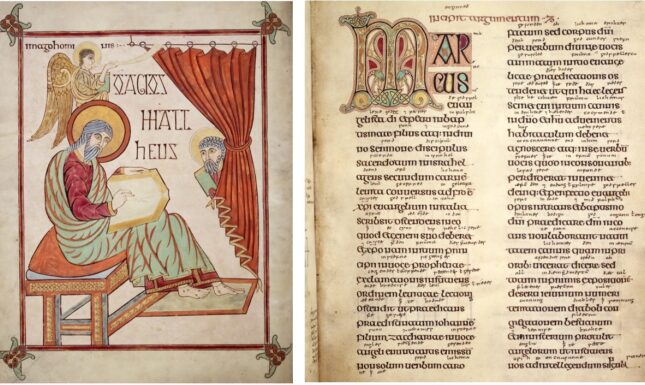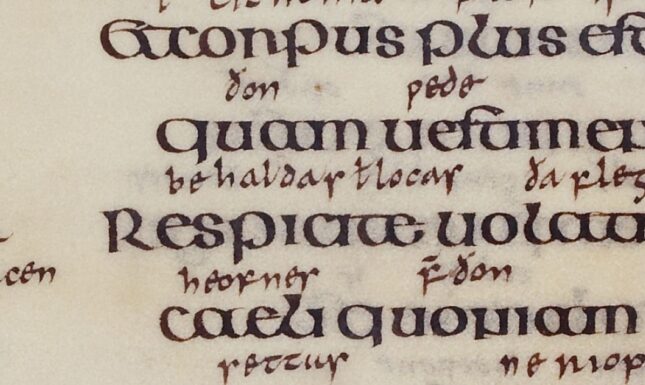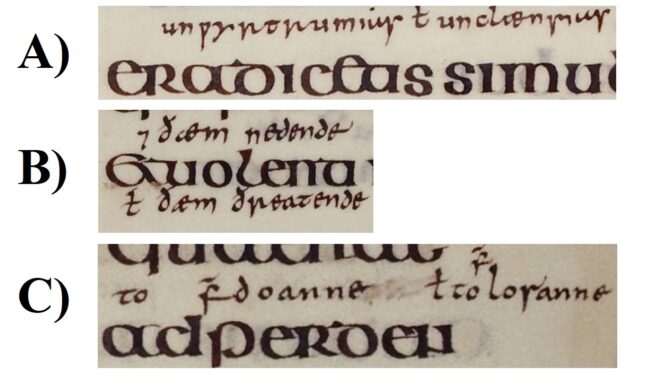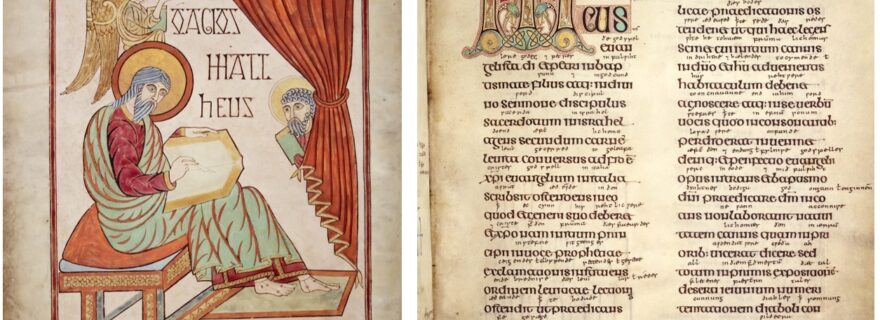A conditioned scribe: The use of multiple interlinear glosses to the Lindisfarne Gospels
What happens when early medieval glossators provide multiple translations for one and the same Latin word and what can this tell us about language history?
To be or not to be conditioned, that was my question. I have many times wondered why it is not possible to travel back in time, especially since embarking in my research into past periods of the English language. One such time was a few years ago, while staring at a facsimile copy of the beautiful Lindisfarne Gospels (British Library, Cotton Nero D.iv) at the University Library in Cambridge, wondering why Aldred the scribe was doing what he was doing, and why it was that I could not travel to 10th-century Northumbria and ask him directly.


The Lindisfarne Gospels
The Lindisfarne Gospels (Fig. 1a) is a copy of the Holy Gospels created during the 8th century at Lindisfarne, a small island off the north-eastern coast of England. As was customary at the time, the main body of the gospels was written in Latin. In between the Latin, however, late Old English interlinear glosses were added during the 10th century by a monk and scribe by the name of Aldred, who wrote in a distinct Northumbrian dialect characteristic of the northeast area in Britain. These Old English interlinear glosses (in red) can be seen in between the Latin text (in black) on Fig. 1b. By having translated the Holy Gospels into his native Old English, Aldred provided us with the first ever English translation of the text.
Recorded history of the English language
The interlinear glosses to the Lindisfarne Gospels have been studied for centuries. From a linguistic perspective, this is easy to understand. The late Old English period (circa 9th century) was a time of considerable linguistic change, when the fairly synthetic (case-driven) Old English was beginning to show considerable and consistent loss of case marking and grammatical distinction. As such, a text written (or glossed) in the 10th century would allow language enthusiasts like me to observe linguistic change in the making. And that is indeed the case with the glosses to the Lindisfarne Gospels. Many linguists before me have turned to these glosses from a variety of linguistic perspectives, whether interested in the phonology of the text, morphology, individual lexical items or Aldred’s glossing practice. In all these areas of linguistic study, the glosses to the Lindisfarne Gospels have proven to be extremely valuable and informative. This is mainly because they record the early stages of a great variety of linguistic changes (phonological weakening, loss of grammatical distinction, reduction of declensional classes, borrowing of Scandinavian words, and so on) which anticipated the state of affairs found in the Middle English period.
Morphological change in the making
My approach to the late Northumbrian glosses found in the Lindisfarne Gospels manuscript has been morphological. By morphology, I mean the form in which words express their grammatical function by means of inflectional endings. Think about the way the word house indicates a singular entity, whereas the addition of a final -s to the word (houses) indicates plurality. The -s in houses is the plural inflection. Nouns are not the only parts of speech which add inflections; verbs do too! Think about the difference between I read versus she reads, where the -s ending is the only remnant of explicit verbal inflection found in the present verbal system of modern English. In Old English, there were many other ways in which verbs were inflected and categorised (for further details see Mitchell & Robinson 2009). My research into the Northumbrian glosses has focused on verbal morphology. I am interested in how the verbal system is represented in these late Old English glosses, and what these glosses can tell us about the process and the dynamics of linguistic change. As such, some years ago, I set out to study the morphology of a specific subset of Old English verbs known as weak verbs class 2. These verbs are rather characteristic since they contain a medial vowel (known as -i- formant) in between the verbal stem and the inflectional ending: lōcian ‘to look’, lōcio ‘I look’, lōcias ‘look!’. As you can tell by the translations, this -i- formant was lost. And it is in the Old English glosses to the Lindisfarne Gospels that this linguistic change is first recorded. Fig. 2 below shows the Latin imperative plural verbal form respicite ‘look’ being glossed in Old English by two different verbs: behaldas ł locas ‘behold ł look’. Note how locas ‘look’ already lacks the -i- formant.


Multiple glosses and morphological conditioning
Let me take you back to the Spring of 2017, when I was at the University Library in Cambridge, with a facsimile copy of the Lindisfarne Gospels, trying to work out why and how the -i- formant in weak verbs class 2 was being lost. I had already identified a few factors which seemed to help the deletion of this medial vowel, such as the phonological weight of the verbal root (light versus heavy), or the shape of the inflectional ending (vocalic versus consonantal ending). Prior to this day, I had paid little particular attention to the so-called multiple glosses in the gospels. As their name indicate, multiple glosses provide multiple Old English translations for the Latin word glossed. For instance, behaldas ł locas ‘behold ł look’ in Fig. 2 above glossing Latin respicite ‘look’. That evening, however, I thought I saw something interesting happening with these multiple glosses, and I decided to look more closely into them.
Here are a few more examples, all taken from the glosses to Matthew’s gospel:


In order to understand my excitement, I will mention that Fig. 3a contains an instance of a double gloss where both elements are weak verbs class 2: Latin eradicetis ‘you uproot’ glossed as unwyntrumias ł unclænsias ‘you uproot ł you defile’, where both verbs retain the formant. Fig. 3b and 3c, however, contain a first element which is not a weak verb class 2 (they are, respectively, a weak verb class 1 and a strong verb) followed by one which is. As can be seen, weak verbs class 2 retain the medial -i- in Fig. 3a, but lose it in Fig. 3b and 3c. This is also true of Fig. 2, where the weak verb class 2 with no -i- formant (locas) is preceded by a strong verb (beholdas). Admittedly, these are only 4 illustrative examples.
But is this a coincidence? Despite the fact that I was not able to travel to 10th-century Northumbria and ask Aldred, I believe that what we see in these double glosses is not a coincidence. These are, rather, cases which illustrate a phenomenon known as morphological priming or morphological conditioning, whereby the shape of the first element of a multiple gloss conditions the shape of the following element. In the glosses to Matthew’s gospel only, there were many such cases where the scribe who glossed the Lindisfarne Gospels, Aldred, seemed to be conditioned by his previous lexical choices. Further research I carried out some years later unveiled that this phenomenon is not restricted to Matthew’s gospel, but can actually be found throughout the Lindisfarne glosses.
It is, therefore, fascinating to see the many ways in which linguistic change is conditioned. Not only are there purely linguistic factors which drive and condition change (phonological weight, for instance), there are other, less explicit factors which contribute to it, as well, and which are equally illuminating to consider. And these factors include priming or conditioning. As such, linguistic change is a multifaceted phenomenon, and this reality can be clearly seen through the phenomenal Old English glosses to the Lindisfarne Gospels.
Further reading:
- Digitised facsimile of the Lindisfarne Gospels available via the British Library website.
- Brown, M., The Lindisfarne Gospels: Society, Spirituality and the Scribe (London, 2003)
- Fernández Cuesta, J. & Pons-Sanz, S., (eds.), The Old English Gloss to the Lindisfarne Gospels: Language, Author and Context (Berlin, 2016)
- Gameson, R., From Holy Island to Durham: The Contents and Meanings of The Lindisfarne Gospels (London, 2013)


